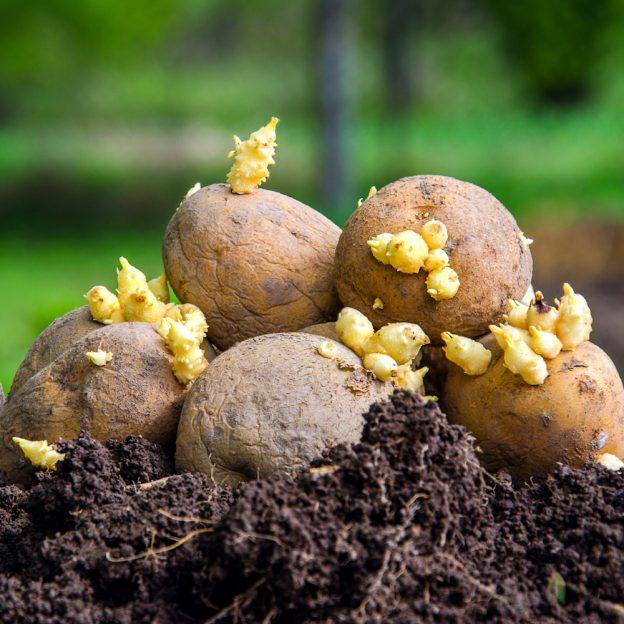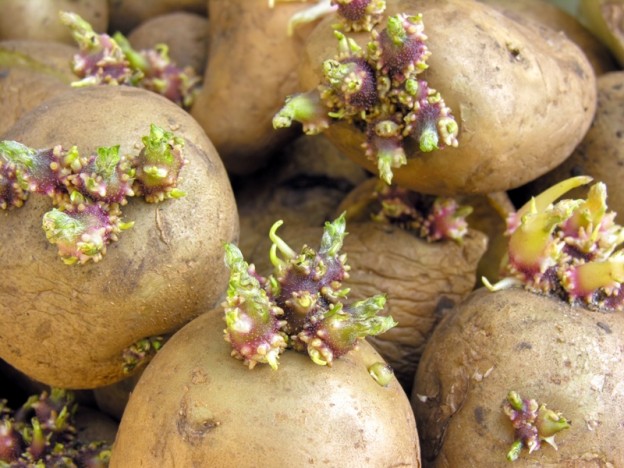Ever fancied eating your own home grown spuds and not sure how to do it? Wondered why you should are supposed to buy seed potatoes rather than plant your supermarket ones? Well let us shed some light for you…
Why shouldn’t you plant supermarket potatoes?
Your average potato from the supermarket will grow into a potato plant when planted. But it is far better to buy seed potatoes from a garden centre as they will be certified disease free. Seed potatoes were grown to be replanted. These tubers are supplied to you with the intention to grow more from them. They have been certified as disease free and the growers are inspected and their potatoes have a ‘plant licence’. This means that they reduce the risk of crop disease and soil damage. Whilst supermarket potatoes are perfectly fine for us when cooked, when planted they can introduce long-lasting disease to your soil (think Irish potato famine).
Another benefit of seed potatoes is that they are meant to produce high yields and quality plants.
What variety should I choose?
If you are new to growing potatoes, look on our handy labels for varieties that are easy to grow. A small 1kg taster bag is a good place to start and will give you a decent crop. You may want to choose two or three different varieties to extend your cropping period.
Finally, make sure you buy varieties that suit your cooking! Some varieties chip and roast well while others are better for boiling and mashing.
Remember our staff are always pleased to help you and will gladly advise on your selection.
I’ve heard that some potatoes are earlier than others
Potatoes are classified into three groups…
First Early Varieties – These potato varieties will give you the first harvest of new potatoes of the summer. Think small salad potatoes.
Second Early Varieties – Second earlies will be ready to harvest just after the first earlies, approximately 2 weeks down the line.
Maincrop Varieties – Maincrop potatoes are the ones you leave to mature, so you can lift them at the end of the season and store them for use during winter. Think crispy roasties with your Christmas meal.
Think about where are you going to grow the potatoes. Maincrop potatoes tend to take up a fair amount of space so if you have an allotment or large plot these are perfect. If, however, you are short of space and would rather grow potatoes in a container or potato grow bag then look out for first or second earlies. Equally if you want to harvest your crop in summer when they tend to be expensive in the shops, buy first earlies.
Seed potatoes won’t store until next year so only buy what you intend to plant this year.
Chitting!
Before you plant your potatoes we recommend you chit them (please note spelling – we are not being rude)! February is the best time to start chitting potatoes, which basically is encouraging them to sprout before planting. This makes them grow quicker and leads to a bumper harvest.
If you have only a few potato tubers, line them up in egg cartons. If you’re doing lots of chitting, put them in open boxes with something like bubble wrap or newspaper in between to keep them upright. Place your box in a naturally light place slightly warm like a porch or unheated greenhouse.
Keep an eye on your potatoes, you need to wait for strong, short green shoots to appear (usually in 4-6 weeks) that are about 2-3 cms long from the eyes of each tuber. If you want to maximize the size of your potatoes when they crop, rub off all but three or four at the top end of the tuber before planting out. If you leave all the shoots intact you’ll end up with lots of smaller potatoes.
Now simply follow the instructions on your packet and plant your potatoes. Good luck!









